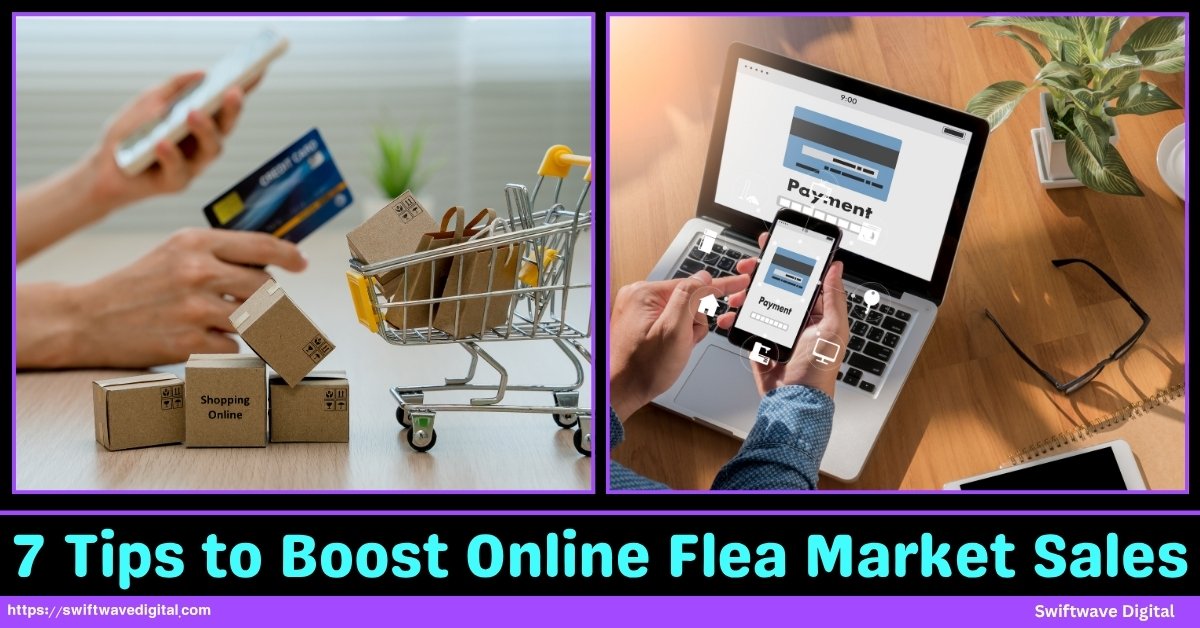Online Flea Market platforms have completely transformed how people buy and sell pre-owned, handmade, or collectible goods.
What once required setting up tables in a weekend bazaar can now be done from your living room reaching thousands of potential buyers worldwide.
Platforms like eBay, Etsy, Facebook Marketplace, and Poshmark have created an entirely new digital ecosystem where sellers can turn clutter into cash and hobbies into steady income streams.
With the global resale market expected to hit $350 billion by 2027 (Statista, 2024), the opportunity to profit is massive — but so is the competition. Simply listing items online isn’t enough anymore.
Today’s buyers expect professional photos, fast communication, fair pricing, and trustworthy sellers. Whether you’re an individual seller or running a small online thrift business, success depends on strategy, presentation, and consistency.
7 Tips to Boost Online Flea Market Sales
In this guide, we will explain 7 proven and practical tips to boost your online flea market sales and build a strong, profitable presence in this fast-growing Digital Marketplace.

1. Optimize Product Listings Like a Search Engine
Your product listing is the foundation of your online flea market success. It’s how potential buyers find your items and decide whether to click or scroll past.
Every major marketplace eBay, Etsy, Facebook Marketplace — operates like a mini search engine. The system scans your title, description, and keywords to match buyer searches.
If your listing doesn’t contain the right keywords or structure, it simply won’t appear in search results.
Start with your title it should include the main keywords a buyer would type when searching. Instead of writing “Beautiful Lamp,” use something like “Vintage Brass Table Lamp 1970s Retro Home Decor Lighting.” This gives clarity and helps the algorithm categorize your product correctly. Keep titles short but complete — ideally under 80–100 characters.
Your description should be factual and structured. List size, material, brand, condition, and any unique features. Avoid vague phrases like “great condition” or “almost new.”
Instead, use specific details like “minor scratch on the base” or “used once, fully functional.” This builds trust and avoids unnecessary returns.
Add tags or keywords if your platform allows it. For example, on Etsy or eBay, include tags like “retro,” “home decor,” or “collectible.” The more accurate your tags, the higher your chances of being discovered by the right audience.
Lastly, make sure to include measurements and shipping details. Buyers want all the information upfront. The more complete your listing, the fewer questions you’ll get — and the faster you’ll sell.
2. Use Professional Photos That Tell the Truth
Photos are what sell your product before the description even gets read. Online buyers rely entirely on visuals to make decisions. If your photo looks dull, cluttered, or unclear, they’ll skip your listing immediately.
You don’t need an expensive camera a smartphone with good lighting is enough. The key is clarity and honesty. Use natural light whenever possible, preferably during the morning or late afternoon when light is soft. Avoid flash because it creates glare and unnatural shadows.
Take at least five to six photos per product. Include front, back, side, and close-up angles. Show labels, brand tags, and any wear or defect. Buyers appreciate transparency and are more likely to trust your listing if they see you’re upfront about imperfections.
Use a plain background — white or neutral colors work best. It keeps focus on the product and looks professional. If the product is small, you can use a lightbox or white sheet.
Keep editing to a minimum. Adjust brightness or contrast only if needed, but don’t use heavy filters. Over-editing makes buyers suspicious and can lead to returns. Simple, real, and clear images perform best.
Remember — accurate photos build credibility and save you time dealing with questions or complaints later.
3. Price Competitively Without Killing Profit
Pricing decides whether your product sells fast or sits unsold for weeks. Buyers on online flea markets compare listings instantly. If your price is too high, they scroll away. Too low, and you lose profit unnecessarily.
Start by researching similar sold listings not just listed ones. Search for the exact or similar product and check what buyers actually paid. Use that as your reference point.
Include your fees and shipping in your pricing calculation. Most marketplaces charge 10–15% commission, plus payment and listing fees. If you offer free shipping, include that cost in your base price so you don’t lose money.
Try tiered pricing strategies. For rare, in-demand, or well-preserved items, go slightly above market price. For common or bulk items, price competitively to sell faster. Small discounts, such as “Buy 2 Get 10% Off,” help boost average order value.
Avoid emotional pricing don’t price based on what the item means to you, price based on what the market values it at. Buyers make decisions rationally when comparing items side-by-side.
Lastly, review your prices monthly. Market demand changes, especially for seasonal products. Adjusting prices regularly helps you stay relevant and profitable.
4. Leverage Trust Builders — Reviews, Transparency, and Speed
Trust is everything in online selling. Buyers can’t touch or test your items, so they rely entirely on how credible you appear. Building trust requires consistent honesty, clear communication, and quick action.
The first step is reviews. Encourage every satisfied buyer to leave a review. After an order is delivered, send a short, polite message thanking them and reminding them to leave feedback.
Good reviews attract more buyers — listings with reviews get several times more clicks than new or unrated ones.
Next, maintain complete transparency in every listing. Clearly describe product conditions. Mention any scratches, dents, or missing parts upfront. Honest listings prevent disputes and returns later. When buyers see transparency, they’re more confident purchasing from you.
Speed is another form of trust. Buyers expect fast responses and quick shipping. Respond to inquiries within a few hours and ship within one or two days whenever possible. Many marketplaces label fast shippers, which directly increases visibility and sales.
Also, package your products carefully. Use protective wrapping and label fragile items. A well-packed parcel tells the buyer you care about their order — and that’s what builds loyalty.
5. Market Beyond the Platform
Relying only on marketplace visitors limits your growth. Smart sellers market their listings beyond the platform to attract steady traffic. The goal is to make your shop visible where potential buyers already spend time.
Start with social media. Use platforms like Instagram, TikTok, and Pinterest to showcase your products. Post short videos showing new arrivals, product uses, or unboxings.
Use hashtags related to your niche — #vintagefinds, #resellshop, #retrodecor. Add your marketplace link in your bio to drive traffic directly to your listings.
Consider Facebook groups or community pages that focus on buying and selling used goods. Engage genuinely, share listings where allowed, and build connections.
If you have returning buyers, start a simple email list. Offer small discounts or early access to new stock in exchange for sign-ups. Send short updates once or twice a month highlighting new products or sales.
You can also use paid ads strategically. Even with a small budget ($5–10 a day), you can run ads targeting people interested in vintage, collectibles, or pre-owned goods. Retarget visitors who viewed but didn’t purchase — those people are your warm leads.
The idea is to create visibility beyond your main selling platform. More eyeballs mean more potential buyers and faster sales.
6. Build a Recognizable Brand — Even in a Flea Market
You might think branding is for big companies, but even a one-person online flea shop needs an identity. Branding is how people remember you and why they return to buy again.
Start with a consistent shop name and logo. Choose a simple, memorable name that reflects your style or niche — like “Retro Rewinds” or “Urban Finds.” Use the same name and profile image across all your platforms for easy recognition.
Maintain a consistent tone in all your communication. Whether you’re writing listings, replying to messages, or posting on social media, use the same clear, professional, and friendly style. Consistency builds familiarity.
Your packaging also plays a role in branding. A simple thank-you card, small sticker, or neatly wrapped parcel makes buyers feel valued. It doesn’t need to be fancy — it just needs to show care.
Add a short note with your social media handle or website link so buyers know where to find you again.
Have a clear and fair return policy. Buyers respect sellers who take responsibility. It shows confidence in what you sell and reduces hesitation during purchase.
The goal of branding isn’t to impress; it’s to build recognition and trust over time. A consistent and professional appearance turns one-time buyers into repeat customers.
7. Track, Test, and Adapt Using Data
Data is the backbone of any successful online business. Without tracking your performance, you’re just guessing what works.
Start by regularly checking your analytics dashboard on your selling platform. Most sites show how many views, clicks, and sales each listing gets. Look for patterns — which items get the most clicks? Which have high views but low conversions? That tells you where to improve.
If a listing gets traffic but no sales, your title or photos might be fine, but your price or description may need adjustment. If something sells fast, consider sourcing similar items or restocking more often.
Track basic metrics monthly — views, conversion rate, repeat buyers, and returns. Keep this data in a spreadsheet if your platform doesn’t provide full analytics.
Small changes often bring the biggest improvements. Update your listings’ titles, try new photos, or adjust prices slightly. Monitor what happens after each change. Over time, you’ll identify what drives consistent sales.
Stay updated on platform trends. Algorithms change, new features launch, and buyer behavior shifts. Sellers who adapt early gain an advantage while others struggle to catch up.
The key is simple — measure, learn, and adjust. That’s how you stay profitable and competitive long term.
Bonus Tip: Offer Bundle Deals and Seasonal Promotions
Bundles and promotions are effective ways to boost average order value and clear inventory faster. Buyers love deals, especially when they feel like they’re getting more value for their money.
Create bundle offers for related products. For example, if you sell vintage books, offer “Buy 2, Get 1 Free.” If you sell home decor, make small item bundles like “3 Retro Vases Set.” It encourages larger purchases and helps move slow stock.
Plan seasonal promotions — discounts during holidays or events like New Year, Valentine’s Day, or summer sales. These limited-time offers grab attention and create urgency.
Clearly display your discounts in titles or cover photos so buyers instantly notice. Example: “Bundle Deal – Set of 3 Vintage Cameras.”
Bundles also save on shipping costs since multiple items go in one parcel. That means better margins for you and better value for the buyer — a win-win.
Avoid overdoing discounts, though. Keep them realistic and time-bound. Consistent small deals perform better than constant deep discounts that reduce perceived value.
Common Mistakes That Kill Flea Market Sales
Even with effort, many sellers lose potential sales because of simple, avoidable mistakes. Here are some of the most common ones and how to fix them:
1. Overpricing Without Market Research: Many sellers price based on what they think an item is worth rather than what buyers are paying. Always check completed listings to find the real market price.
2. Poor or Misleading Photos: Blurry, dark, or filtered images turn away buyers. Always use natural lighting and show all sides clearly.
3. Slow Communication: Buyers expect quick replies. Responding late often means losing sales to faster sellers.
4. Weak Descriptions: Short or vague descriptions create confusion. Always include details like size, brand, material, and condition.
5. Ignoring Repeat Buyers: Sellers often focus on new customers and forget existing ones. A simple thank-you message or loyalty discount can turn one-time buyers into regulars.
6. Ignoring Platform Analytics: Not checking performance data means you never know what’s working. Regularly analyze which listings perform well and which need changes.
7. Inconsistent Branding: Changing shop names, styles, or tone confuses customers. Keep everything uniform to build recognition.
8. Neglecting Shipping Quality: Poor packaging or delays damage your reputation. Always pack items securely and ship on time.
Avoiding these mistakes alone can improve your sales performance significantly — often more than any new marketing trick.
Conclusion
Succeeding in an online flea market isn’t about luck it’s about strategy, consistency, and trust.
The sellers who thrive understand that every detail matters: how their listings are written, how their photos look, how quickly they respond, and how honestly they describe their products. Each of these factors builds credibility and sets you apart from casual sellers who just post and wait.
The market is more competitive now than ever, but it’s also more rewarding.
Millions of buyers actively search for quality secondhand, vintage, and collectible items daily. If your listings are optimized, priced smartly, and backed by great service, there’s no reason you can’t capture a large share of that audience.
Focus on clarity, transparency, and consistency. Treat every product like a representation of your brand — because it is. Keep improving your listings, tracking your data, and testing new ideas.
Over time, small, steady improvements will stack up and create meaningful growth.
With these proven methods, you can turn a simple online flea market shop into a reliable, profitable, and sustainable business.



